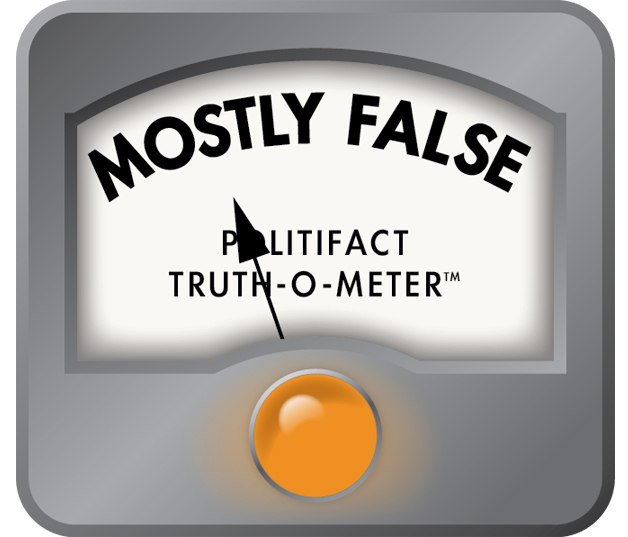Stand up for the facts!
Our only agenda is to publish the truth so you can be an informed participant in democracy.
We need your help.
I would like to contribute

Even with an eight-figure salary, Green Bay Packers quarterback Aaron Rodgers doesn't pay the highest tax rate, U.S. House Speaker Paul Ryan says. (Rick Wood/Milwaukee Journal Sentinel)
Paul Ryan's misleading claim about a single mom, not Aaron Rodgers, paying the highest tax rate
A Dominican nun took the microphone at a CNN town hall in Racine, Wis. with U.S. House Speaker Paul Ryan, noted that they are both Catholics, and said to him:
I’d like to ask you how you see yourself upholding the church’s social teaching that has the idea that God is always on the side of the poor and dispossessed.
The Janesville Republican responded, in part, by referring to the Green Bay Packers’ star quarterback -- and arguing that welfare programs need to be reformed so that they don’t discourage work.
Alluding to high tax rates he had criticized earlier in the Aug. 21, 2017 forum, Ryan said:
I was telling you about these successful small businesses in Wisconsin -- they’ve got a 44.6 percent tax rate. That’s not the highest tax rate payer. I mean, Aaron Rodgers -- who deserves every salary -- is not the highest tax rate payer in this state. You know who it is? It’s the single mom getting 24 grand in benefits with two kids who would lose 80 cents on the dollar if she goes and takes a job. We have to fix that.
Ryan essentially repeated the claim three days later while visiting Boeing in Washington State, comparing the aerospace giant and its corporate tax rate to the same single mother. He has also made nearly the same claim in the past, including at least twice in 2016.
An unemployed single parent on public assistance who takes a job doesn’t suddenly start paying an income tax rate of 80 percent.
And though Ryan has a point, the example he gives is rare, not common.
Tax rates
For 2017, Rodgers’ contract with the Packers pays him a base salary of $12.55 million. That alone puts him in the income brackets with the highest tax rates:
-
7.65 percent for Wisconsin, which applies to taxable incomes over $244,750
-
39.6 percent for federal, for taxable incomes of $418,401 and over
That means Rodgers’ marginal rate -- the amount paid on the last dollar of income -- is a total rate of 47.25 percent. (The state rate plus the federal one.)
So, what happens to the unemployed single mother, in Ryan’s scenario, who takes a job?
Marginal tax rates
Ryan spokesman Ian Martorana told us Ryan’s reference was not to the income tax rate paid by the single mother, but rather her effective marginal tax rate -- which takes into account public benefits that are lost as a result of an increase in income. Think of losing benefits as a result of taking a job as a tax.
Ryan argues that by taking a job, the woman in his example would lose 80 cents in benefits for every $1 in income earned from taking a job. That would be a marginal tax rate of 80 percent.
Experts told us that wouldn’t be the highest marginal tax rate anyone pays, but it would be among the highest.
The problem is, Ryan’s statement suggests the 80 percent rate is relatively common.
Experts told us it’s possible, but very rare, that a single unemployed parent could collect $24,000 a year in public benefits. She likely would need to receive relatively uncommon housing assistance in addition to food stamps, Medicaid and other benefits.
The experts also said such a person would be hit with what amounts to an 80 percent tax rate only if she takes a job within a narrow income range above the poverty level -- not, for example, if the job pays minimum wage.
A 2015 research paper Ryan’s office cited to us from the nonpartisan Congressional Budget Office does not provide marginal tax rates for a single parent like the one Ryan described. However, for a single parent with one child -- and only within a narrow income range -- the marginal tax rate for 2016 averaged 75 percent
Another source cited by Ryan, 2015 testimony to Congress from the nonprofit Urban Institute, also said marginal tax rates can reach 75 percent.
But that occurs among relatively few people -- poverty-level workers who not only receive benefits such as food stamps and health insurance, but much less common housing assistance, and then begin earning higher incomes within a narrow range above the poverty level.
In contrast, an unemployed person who takes a job would almost never face an 80 percent marginal tax rate, experts told us. That’s because while a newly employed person might lose some benefits by becoming employed, she would gain benefits from earned income and child care tax credits that come with taking a job.
Other data
For example, in a 2014 paper, the Center on Budget and Policy Priorities, a left-leaning think tank, argued that a single mother of two is better off by taking a job, even if it pays only $12,000 per year. She would lose some food stamps and have to pay income taxes. But by gaining the earned income and child tax credits, "that $12,000 job leads to a $16,630 increase in income," according to the paper.
Only in narrow circumstances -- with an income of less than $29,000 and receiving "an unusual combination of government benefits" -- would the marginal tax rate for a single mother of two exceed 80 percent, according to a 2016 paper by the center.
"In the overwhelming majority of cases, in fact, adults in poverty are significantly better off if they get a job, work more hours, or receive a wage hike," that paper said.
At the same time, even if marginal tax rates don’t reach 80 percent for most lower-income people, they are perceived as a problem.
The paper from the nonpartisan CBO says "when marginal tax rates are high, people tend to respond to the smaller financial gain from employment by working fewer hours, altering the intensity of their work, or not working at all."
And Wisconsin Taxpayers Alliance president Todd Berry told us: "It is a real problem for anyone moving up the income scale from poverty, because so many of these programs are income-conditioned. The main point to be made here is how these programs are designed can create powerful disincentives" to work.
Our rating
Ryan says Aaron Rodgers "is not the highest tax rate payer" in Wisconsin, it's "the single mom getting 24 grand in benefits with two kids who will lose 80 cents on the dollar if she goes and takes a job."
There’s some mixing of apples and oranges here. The reference to Rodgers is for the actual highest rate he would pay for income taxes. With regard to the single mother, Ryan is referring to her marginal tax rate -- how much in public benefits she would lose by taking a job.
Ryan is correct that it’s possible for the woman he describes to lose 80 cents in benefits for every $1 in income earned -- an 80 percent marginal tax rate. But that occurs in very rare cases where the mother would be receiving a higher than typical set of public benefits and would take a job within a narrow income range above the poverty level.
The vast majority of lower income people aren’t hit with a marginal tax rate as high as 80 percent, although even lower rates are considered strong disincentives to work. And advocates for the poor say the unemployed generally are better off financially by taking a job, even if they lose some public assistance.
For a statement that contains some element of truth but ignores critical facts that would give a different impression, our rating is Mostly False.
A footnote
Ryan had been under criticism for not holding town halls in his southern Wisconsin district that were open to the public. We rated as Mostly True a claim from Randy Bryce, a Democrat who is running for Ryan’s seat in 2018, that Ryan had not done a public town hall in the district for more than 600 days.
Ryan had turned to telephone town halls and events held in workplaces, which had limited public access. The CNN event was something of a hybrid: members of the public could apply to CNN to attend, but it was not like a traditional town hall held in a public building that anyone could enter.
In Racine, Ryan drew headlines for criticizing remarks made by President Donald Trump about racial violence nine days earlier in Charlottesville, Va. But a portion of the CNN town hall was spent discussing taxes.
More on Ryan, Rodgers and taxes
In Context: Scott Walker, Aaron Rodgers and Brett Favre
True: Ryan says the U.S. "tax rate on successful small businesses is 44.6 percent," while the business tax rate in Canada is 15 percent.
Mostly True: Trump in Wisconsin says America’s federal business tax rate is the highest "in the world."
Our Sources
YouTube, CNN Paul Ryan town hall (0:50), Aug. 21, 2017
Email, Paul Ryan spokesman Ian Martorana, Aug. 22, 2017
Interview, Wisconsin Taxpayers Alliance research director Dale Knapp, Aug. 22, 2017
Email, Wisconsin Taxpayers Alliance president Todd Berry, Aug. 22, 2017
Wisconsin Department of Revenue, "Tax rates," April 3, 2017
Forbes, "IRS Announces 2017 Tax Rates, Standard Deductions, Exemption Amounts And More," Oct. 25, 2016
Congressional Budget Office, "Effective Marginal Tax Rates for Low- and Moderate-Income Workers in 2016," November 2015
Urban Institute, "Statement of C. Eugene Steuerle On Marginal Tax Rates and 21st Century Social Welfare Reform," June 25, 2015
Center on Budget and Policy Priorities, "It Pays to Work: Work Incentives and the Safety Net," March 3, 2016
Interview, Kids Forward research director Jon Peacock, Aug. 24, 2017
Interview, Urban Institute senior research associate Elaine Maag, Aug. 25, 2017
Interview, Center on Budget and Policy Priorities senior fellow Sharon Parrott and tax policy analyst Brendan Duke, Aug. 25, 2017
Center on Budget and Policy Priorities, "Policymakers Often Overstate Marginal Tax Rates for Lower-Income Workers and Gloss Over Tough Trade-Offs in Reducing Them," Dec. 3, 2014
Email, Wisconsin Democratic Party spokeswoman Gillian Drummond, Aug. 24, 2017
Browse the Truth-O-Meter
More by Tom Kertscher
Paul Ryan's misleading claim about a single mom, not Aaron Rodgers, paying the highest tax rate
Support independent fact-checking.
Become a member!
In a world of wild talk and fake news, help us stand up for the facts.






 PolitiFact Rating:
PolitiFact Rating: 

























